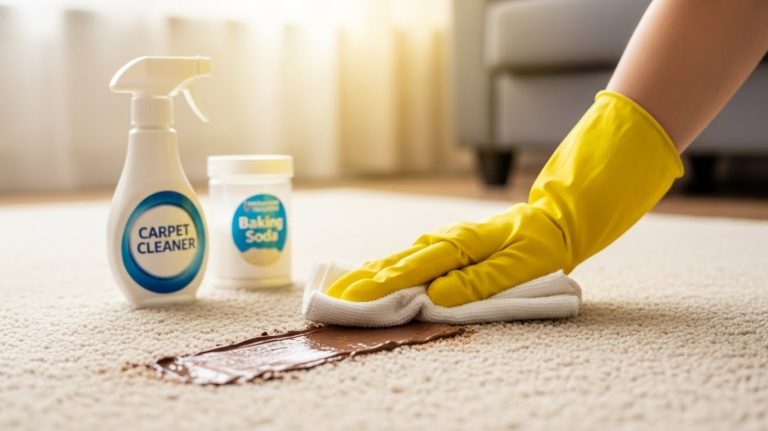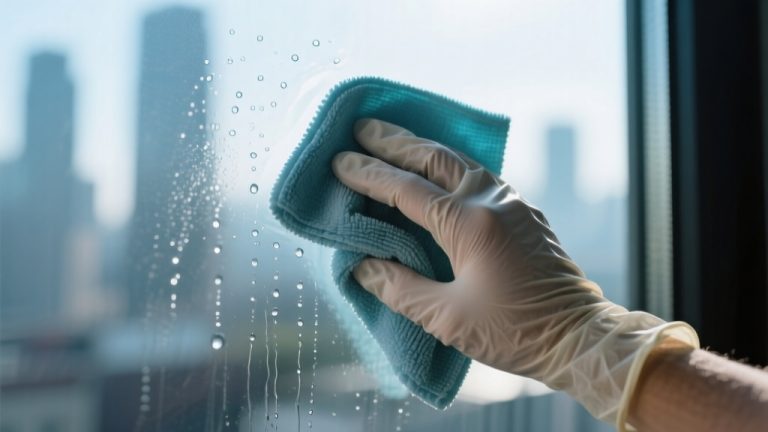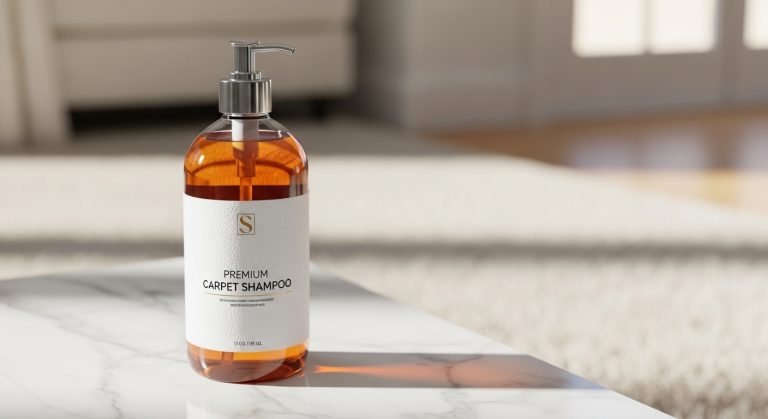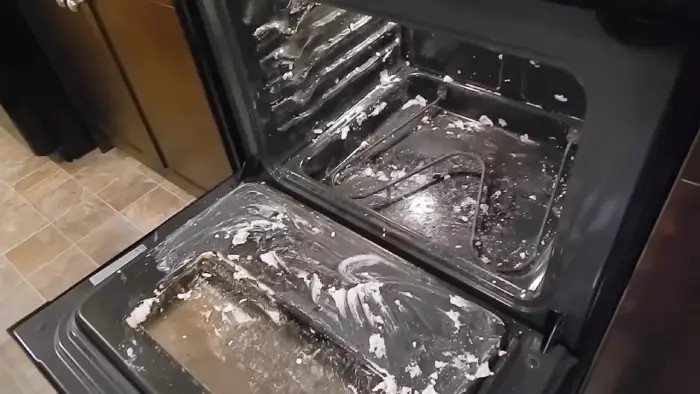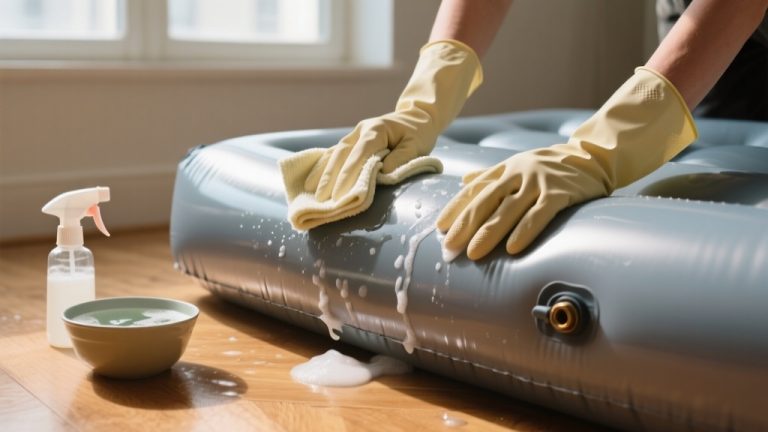How to Remove Tea Stains From a Carpet? Quick and Easy Steps
If you spill tea on your carpet, immediately blot the excess liquid without rubbing to avoid spreading. Lightly dab the stain with cold water and blot again.
Test a homemade paste of baking soda and vinegar or a diluted hydrogen peroxide spray on a hidden spot before applying. Gently apply your chosen solution, let it sit briefly, then blot and rinse lightly.
Finally, air dry thoroughly to prevent mold. Following these steps will guarantee your carpet recovers well, and you can explore more detailed techniques to perfect the process.
Key Takeaways
- Blot excess tea immediately with a clean cloth, working from the stain’s edges inward to prevent spreading.
- Test cleaning solutions like baking soda paste, vinegar, or hydrogen peroxide on a hidden carpet spot first.
- Apply a baking soda and vinegar paste or a diluted hydrogen peroxide solution to lift tannin-based tea stains.
- Avoid over-saturating the carpet; gently blot and rinse treated areas with cold or warm water.
- Air dry the carpet thoroughly in a ventilated area and vacuum residue once dry to restore texture.
Immediate Steps to Take When Tea Spills on Carpet
When tea spills on your carpet, acting immediately can prevent a stubborn stain from setting. First, grab a clean, dry cloth or paper towel to blot the excess liquid—avoid rubbing to stop the stain from spreading or sinking deeper.
Blot from the outer edge toward the center, replacing cloth sections as they saturate to maximize absorption. Using clean, dry cloths to absorb moisture is crucial to avoid spreading the stain. It is also important to work in a well-ventilated workspace to ensure quick drying and prevent mold growth.
Next, lightly moisten the stained area with cold water on a cloth to dilute the tea, repeating moistening and blotting cycles carefully to avoid oversaturation. Then, apply a white vinegar and cold water solution (1:2 ratio) to the stain, letting it sit five minutes to break down tannins before blotting again.
Preparing Your Carpet for Stain Removal
Start by gently blotting the tea stain to absorb as much liquid as possible without spreading it further. Acting promptly with immediate blotting can help prevent the stain from setting.
Next, gather all necessary cleaning supplies, including appropriate solutions and tools, to guarantee you’re prepared for effective treatment.
Before applying any solution, always test it on a hidden carpet area to avoid damage or discoloration. It is also important to identify the stain type since tea is a tannin-based stain, which helps in selecting the most effective removal method.
Initial Stain Absorption
Although tea stains can set quickly, you can limit their damage by immediately blotting the spill with a clean, dry cloth to absorb excess liquid without rubbing. Use kitchen towels or microfiber cloths for better absorption, pressing firmly but gently from the stain’s edges toward the center to avoid spreading.
It is important to act quickly because treating stains as soon as possible facilitates easier removal. Additionally, managing moisture levels carefully during cleaning is essential to protect carpet fibers from potential damage caused by excessive wetness or heat.
Next, dampen a clean cloth with cold water and lightly blot the area to dilute the stain—avoid over-wetting to prevent damage. Repeat moistening and blotting to lift more tea while keeping the carpet damp, not soaked.
Act fast, minimize foot traffic, and avoid scrubbing to protect fibers and backing. Before applying any stain remover, ensure the carpet is blot-dried yet slightly damp, and gather all materials.
Testing Cleaning Solutions
After you’ve carefully blotted and dampened the tea stain, the next step involves testing your cleaning solutions on a hidden section of the carpet. Choose an inconspicuous spot, apply a small amount of solution, blot gently, and let it sit for 10–15 minutes.
Rinse with cold water and blot dry. Observe any changes in color, texture, residue, odor, and stain removal. This prevents damage and guarantees compatibility before full treatment.
Since rubbing alcohol is a powerful solvent, using it safely and effectively requires ensuring proper ventilation and wearing gloves during application. Additionally, avoid oversaturation to prevent moisture buildup that can lead to mold growth.
| Test Aspect | What to Check |
|---|---|
| Color Fastness | Bleaching, darkening, bleeding |
| Texture | Stiffness, fuzziness, matting |
| Residue | Sticky or powdery deposits |
| Odor | Chemical smells after drying |
| Stain Removal | Effectiveness on tea discoloration |
If adverse effects appear, discontinue use immediately.
Gathering Cleaning Materials
Gather all necessary cleaning materials before treating the tea stain to guarantee a smooth and effective process. Start by assembling soft cloths or paper towels for gentle blotting, and a vacuum cleaner to remove any dry residues.
Prepare clean bowls or containers for mixing solutions, and measuring spoons for accuracy. Have spray bottles ready for even solution application. Gloves will protect your hands from acidic agents like vinegar or borax.
Include liquid components such as white vinegar, dish soap, warm water, and optionally lemon juice or baking soda for paste making. It is important to read product labels carefully when choosing cleaning agents to avoid damage to carpet fibers.
Equip yourself with soft-bristled brushes and spoons to apply and remove cleaners without damaging fibers. Immediate treatment minimizes the risk of permanent staining, so having all materials ready helps ensure prompt action.
Finally, verify the carpet is vacuumed and surface dry before treatment, and test solutions on a hidden spot to confirm colorfastness.
Effective Homemade Cleaning Solutions for Tea Stains
You can tackle tea stains effectively with homemade solutions like a baking soda and vinegar paste that breaks down pigments gently yet thoroughly. It is important to blot the stain immediately using a clean cloth to prevent it from setting deeper into the fibers, similar to the immediate response recommended for water stains on leather.
Borax offers a powerful alternative when applied carefully, especially when combined with damp cloth pressing to lift stains. However, it is important to remember that DIY methods may not fully eliminate all stains or odors and can sometimes cause damage to delicate carpet fibers.
For tougher spots, a hydrogen peroxide mixture can lighten and remove discoloration without harsh chemicals. After treatment, allowing the carpet to air dry naturally in a well-ventilated space helps avoid residual moisture that could lead to mold or mildew growth, a common risk noted in leather care.
Baking Soda Vinegar Paste
Although tea stains can be stubborn, a baking soda vinegar paste offers an effective homemade solution that tackles discoloration and odors without harsh chemicals.
To prepare, mix ½ cup baking soda with ¼ cup white vinegar slowly, forming a thick paste. Test on a hidden carpet spot to ensure no color fading. Since porous materials absorb liquids similarly, understanding porosity effects can help in stain removal.
Blot excess tea, then apply the paste generously over the stain. Let it sit at least 15 minutes—longer for tougher stains. Before treatment, it is important to vacuum thoroughly to remove surface dust and debris from the carpet.
Once dry, vacuum thoroughly to remove residue. Baking soda’s mild alkali lifts dirt while vinegar’s acidity breaks down tea tannins and neutralizes odors. This natural reaction produces bubbles that help lift stain particles without saturating the carpet.
Repeat if needed, and always dry the carpet well to prevent damage or mold growth.
Borax Application Tips
When tackling tea stains with borax, it’s crucial to start with a spot test on a hidden area of your carpet to guarantee the substance won’t damage fibers or affect color.
Prepare a borax solution by mixing equal parts borax and warm water with a few drops of dish soap. Proper ventilation during cleaning is recommended to help any chemical fumes dissipate quickly.
Apply carefully to avoid spreading the stain. Use blotting and gentle pressing to lift the tea residue.
After treatment, rinse and dry thoroughly to prevent mold or damage. It is also helpful to work from the outside of the stain inward to penetrate and break down the tea particles effectively.
Keep these tips in mind:
- Always test borax on a concealed spot first
- Avoid soaking carpet; control moisture
- Use a spray bottle for even application
- Blot, don’t rub, to prevent stain spread
- Vacuum after drying to remove residue
Hydrogen Peroxide Mixture
Since hydrogen peroxide can effectively break down tea stains without harsh chemicals, it’s a popular choice for homemade carpet cleaning solutions. Use a 3% concentration mixed equally with water in a spray bottle. This method aligns with eco-friendly solvents that reduce environmental harm.
Before applying, test on a hidden carpet patch to check for colorfastness. Spray the mixture generously but avoid soaking the fibers.
Gently agitate the stain from edges to center with a soft brush or cloth, then let it sit for 5 minutes. It is important to regularly check for any color loss or bleaching effects during treatment.
For stubborn stains, cover the area with a towel and wait up to 30 minutes to prevent light exposure from degrading the solution.
Rinse lightly with warm water, blot excess moisture, and allow the carpet to dry fully before vacuuming. Repeat as needed, always ensuring proper ventilation and wearing gloves during application.
Using Borax Safely to Treat Tea Stains
Because borax is a powerful natural cleaner, you need to handle it with care to treat tea stains safely. Before applying borax, test it on a hidden carpet area to avoid discoloration.
Use gloves and ensure good ventilation to minimize health risks. Apply borax solution or paste without saturating the carpet, and never leave residue unwashed as it may irritate or attract dirt. For fresh spills, you can sprinkle borax over the damp spot to help draw out the stain effectively. Proper surface preparation is crucial for effective stain removal and to ensure long-lasting protection.
Keep these safety precautions in mind when using borax:
- Test on a small, hidden area first
- Avoid soaking the carpet; keep it damp only
- Wear gloves to protect your skin
- Work in a well-ventilated space
- Rinse thoroughly to remove all borax residue
Best Techniques for Applying Stain Removers
Handling borax with care sets a strong foundation for effective stain removal, but applying any stain remover properly is just as important to protect your carpet and maximize results.
Apply the remover sparingly with a spray or cloth, gently work it into fibers, then blot instead of rubbing. Avoid over-wetting to prevent damage and mildew.
For stubborn stains, enzyme-based formulas that target organic and protein stains can be especially effective when left to sit for an extended period.
| Step | Action | Tip |
|---|---|---|
| Apply | Spray/dab on stain | Use minimal amount |
| Work In | Gently massage with fingers | Avoid harsh scrubbing |
| Blot | Use clean, dry cloth | Move from edges to center |
Repeat if needed, always testing first on a hidden area to avoid discoloration or fiber damage. This method balances effectiveness with carpet care.
Tips for Drying and Restoring Carpet After Cleaning
Although cleaning removes stains and dirt, proper drying and restoration are crucial to prevent mold, odors, and fiber damage. To effectively dry your carpet after tea stain removal, focus on maximizing airflow and moisture extraction while delaying furniture replacement.
- Open windows and use fans to boost air circulation and evaporation. Opening windows on opposite sides of the room creates a crosswind that accelerates drying.
- Employ a wet vacuum or extractor to remove deep moisture.
- Use a dehumidifier to control humidity and prevent musty odors.
- Avoid placing furniture back until the carpet is fully dry (6–12 hours minimum).
- Dab surface moisture with microfiber towels to speed drying.
Frequently Asked Questions
Can Tea Stains Cause Permanent Carpet Damage if Left Untreated?
Yes, tea stains can cause permanent carpet damage if you leave them untreated. Tannins in tea bind strongly with carpet fibers, especially over time, creating tough, lasting discoloration.
The longer you wait, the deeper these bonds become, making removal difficult or impossible. Heat exposure worsens this by fixing stains firmly.
To avoid permanent damage, you should act quickly and use appropriate cleaning methods based on your carpet’s fiber type.
Are There Specific Carpet Types More Prone to Tea Stain Absorption?
Think of carpet fibers like thirsty sponges—some soak up tea stains faster than others. You’ll find nylon carpets absorb stains more readily due to their fiber structure, requiring quick action.
Wool varies, depending on its finish, while polyester often resists stains thanks to repellent coatings that let liquids bead up.
Olefin resists moisture well, so it’s less prone to absorption.
Knowing your carpet type helps you tackle tea spills before they settle in.
How Often Should I Clean My Carpet to Prevent Tea Stain Buildup?
You should clean your carpet professionally every 6 to 12 months under normal conditions. But if you have pets, kids, or heavy foot traffic, aim for every 3 to 6 months.
Vacuum frequently—ideally daily—to prevent dirt embedding and stain buildup.
Immediate spot cleaning after spills is vital.
Consistent maintenance stops stains from settling deeply and keeps your carpet looking fresh and lasting longer.
Can Professional Carpet Cleaning Remove Old Tea Stains Better Than DIY Methods?
Sure, you could keep scrubbing your carpet with vinegar and hope the tea stain magically disappears, but professionals have hydro-vac machines and potent spotters like Rave Spotter that actually work. They tackle deep-set tannins that DIY methods barely touch.
While no method guarantees perfection, pros customize treatments to your carpet type, giving you a much better shot at banishing old tea stains than your kitchen concoctions ever will.
Are There Eco-Friendly Alternatives to Borax for Tea Stain Removal?
Yes, you can use eco-friendly alternatives to borax for tea stain removal. Washing soda, baking soda, white vinegar, castile soap, and hydrogen peroxide mixes work well. Each offers natural cleaning power—washing soda tackles tough stains, vinegar breaks down residues, and baking soda deodorizes.
Just handle washing soda carefully and test hydrogen peroxide on a small area first. These options keep your carpet clean without harsh chemicals or environmental harm.
Restore Your Carpet’s Beauty – Act on Tea Stains Today
Think of your carpet as a garden, and tea stains as stubborn weeds. By acting quickly, preparing carefully, and applying the right homemade solutions like a skilled gardener, you’ll nurture your carpet back to health.
Using borax cautiously and following precise techniques guarantees these ‘weeds’ don’t take root. Finally, drying and restoring your carpet is like watering and tending—essential steps to keep your space fresh and vibrant. With methodical care, your carpet will thrive again.


